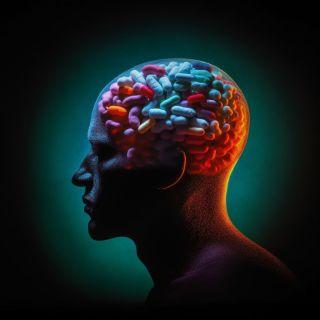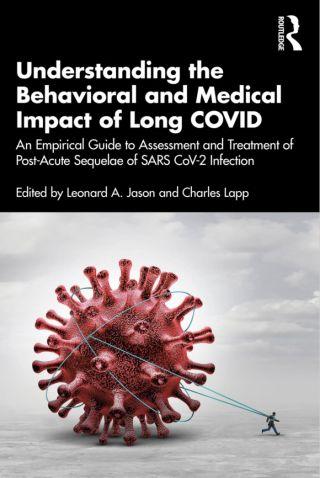PSYCHOSIS-
Antibiotics and the Brain: It’s Complicated.
Antibiotics can both cause and cure psychosis.
Reviewed by Davia Sills
KEY POINTS-
Antibiotics can decimate a person's gut microbes.
An altered microbiota can affect one's mood and cognition.
It may soon be possible to mitigate the damaging effects of antibiotics on the gut.
“Vaccines and antibiotics have made many infectious diseases a thing of the past; we've come to expect that public health and modern science can conquer all microbes. But nature is a formidable adversary.” — Tom Frieden
Antibiotics are a bona-fide medical miracle. When it comes to bacterial infections, nothing compares. Antibiotics have saved millions of lives. Got a cut? Antibiotics. Got strep throat? Antibiotics. Got a cold? Antibiotics. I threw in the last one to see if you are paying attention. Colds are caused by viruses, not bacteria, and antibiotics won’t help even a tiny bit. But so what? Better safe than sorry, right?
The Bad
However, antibiotics have a dark side, and you should be aware of it. Scientists have long known about a direct connection between acute psychosis and certain antibiotics, including penicillin, fluoroquinolones, cephalosporins, and macrolides.
This turns out to be tricky to measure: The reason that antibiotics are administered is because of infection or inflammation, which can itself lead to psychosis. However, causality has been established in cases where the psychosis lifted when the antibiotics were stopped and returned when the antibiotics were resumed.
This isn’t a new finding; doctors have documented a wide variety of mental complications with penicillin since 1945. The list of symptoms is long, including seizures, aphasia, spasms, psychosis, confusion, lethargy, anxiety, and coma.
The How
It’s not just penicillin: The documented psychiatric side effects of antibiotics other than penicillin range from mild symptoms to severe delirium and psychosis. What is this mysterious connection between antibiotics and the brain? The prime suspect is the gut microbiota—the batch of microbes that live in our gut and help us with digestion and defense against pathogens.
Oral antibiotics can seriously damage the microbiota. That is, after all, the whole point of antibiotics: killing bacteria. Studies have shown that your microbiota can affect your brain via the gut-brain axis. Antibiotics can kill bacteria that produce neurotransmitters like GABA, dopamine, and serotonin, and that may affect your cognition and mood. The good news here is that when the antibiotics are discontinued, the mental issues typically resolve quickly.
Challenges to the microbiota can be especially impactful for children. The first 1,000 days of our childhood are special. That’s when our immune system must learn to tolerate our beneficial bacteria. Although the details are still murky, the job must get done, or we will forever be fighting our helpful microbes, setting us up for long-term inflammation.
Getting it right is important for more than just our gut: A proper microbiota helps the brain to develop normally as well. Giving antibiotics during this accommodation period risks killing the bacteria we need. In mice, a lack of bacteria can cause an abnormal stress reaction. Providing those mice with a healthy microbiota puts them back on track, but only if they are younger than three weeks. After that, their stress response can’t recover.
Humans are not mice, but infants who take antibiotics have a less diverse microbiota and are more likely to get IBD and depression as adults. If your child really needs them, don’t hold back, but keep in mind that there might be long-term consequences.
The Good
In 1882, Robert Koch discovered that tuberculosis was caused by bacteria, and soon sanatoriums were established to deal with contagious patients. People with TB are often depressed, and sanatoriums are typically quiet, somber places.
In 1951, researchers decided to trial a new antibiotic, called isoniazid, to treat TB bacteria. To their surprise, the patients reacted weirdly: They started laughing and dancing in the hallways. The staff found themselves shushing their normally reserved patients. The researchers realized that, by pure serendipity, they had discovered the first antidepressant.
They found that isoniazid prevented the breakdown of neurotransmitters, including serotonin, dopamine, and epinephrine. The race was on to find new drugs that could affect neurotransmitters. That focus ultimately led to all the modern antidepressants, including Prozac, Wellbutrin, Zoloft, and others.
Virtually forgotten in all the hoopla: isoniazid is an antibiotic. As well as lifting mood, the drug alters the microbiota. This was an early glimpse at the connection between microbes and brain function, but it was swiftly forgotten.
Another win for antibiotics and mood is hepatic encephalopathy, a liver problem that affects the brain. It can cause anxiety and profound personality changes. It is not new: Hippocrates made a note of patients with liver disease and bad tempers. He said, “Those who are mad on account of bile are vociferous, vicious, and do not keep quiet.”
The culprit is ammonia, which causes edema in the brain. If untreated, it can lead to coma and death. Ammonia is a product of certain gut bacteria. One treatment is lactulose, a sugar that is consumed by lactobacillus bacteria, which multiplies and produces lactic acid. That increased acidity kills off many of those ammonia producers.
Another treatment is rifaximin, an antibiotic that acts directly on gut bacteria. The ability to treat this particular psychosis with antibiotics is another reminder of the unexpected impact our gut bacteria have on our brains.
The Confusing
In third-world countries where infections are endemic, taking antibiotics while pregnant can increase the odds that the baby will have a healthy birth weight. But in high-income countries, antibiotic use during pregnancy is associated with low birth weight. Why is that?
Most mothers don’t know it, but they pass on more than their own genes to their children: They pass down microbial genes as well. So, when the mom gets sick or takes antibiotics, it can affect this microbial heritage. Maternal infections and antibiotic use during pregnancy are associated with increased rates of schizophrenia, autism, anxiety, and depression later in the child’s life.
Before you despair, remember that associations don’t imply causality, and antibiotics during pregnancy can save the life of both the mother and the baby. But it’s worth keeping in mind that broad-spectrum antibiotics may also damage the microbiota in a way that could have a lasting effect on the child.
The Upshot
Antibiotics will degrade some bacterial species, which will allow others to fill the ranks. In a balanced microbiota, these new recruits are good neighbors. But when they are allowed to bloom, they can produce dysbiosis. When you are taking antibiotics, you don’t want to encourage their overgrowth. You may not want prebiotic fiber to amplify the uncertain survivors of an antibiotic battle. Better to eat simple foods like rice and bananas until the antibiotic treatment is over.
When you stop taking antibiotics, you need to restore your friendly old neighborhood of microbes. Your best bet here is to eat a wide diversity of foods with lots of different colorful polyphenols and various types of fiber. A prebiotic blend could be a useful supplement if you can’t get enough diversity of vegetables. A Mediterranean-style diet is a great way to recoup from antibiotic treatment. It’s also delicious.
Alcohol can exacerbate a leaky gut, so use it sparingly. Sodas, candy, and other sweets will feed fungi. Bacteria and fungi have a complex relationship, but when antibiotics knock out bacteria, fungi enjoy a resurgence due to less competition. Fungal overgrowth can be tough to control, so don’t encourage it.
The future
A German study conducted by Lisa Maier, Camille Goemans, and colleagues from the European Molecular Biology Laboratory gives some hope for a better antibiotic outcome. The researchers looked at 144 different antibiotics and monitored how they affected specific gut bacteria. They discovered that several unexpected drugs could protect the gut microbiota against antibiotic damage. These include dicumarol (an anticoagulant), benzbromarone (a gout medication), tolfenamic acid, and diflunisal (anti-inflammatories).
These drugs allowed the antibiotics to attack their targets without killing beneficial bacteria. Maier says this novel approach, combining antibiotics with protective drugs, could reduce the harmful side effects of antibiotics, including psychosis. It will, however, take time to become a standard protocol.
Antibiotics are amazing drugs that have saved millions of lives, but in nature, nothing is black and white. The stories told here demonstrate that the gut-brain connection is vulnerable to antibiotics. That’s an important factor to consider the next time you get an infection.
PSYCHOSIS-
Antibiotics and the Brain: It’s Complicated.
Antibiotics can both cause and cure psychosis.
Reviewed by Davia Sills
KEY POINTS-
Antibiotics can decimate a person's gut microbes.
An altered microbiota can affect one's mood and cognition.
It may soon be possible to mitigate the damaging effects of antibiotics on the gut.
“Vaccines and antibiotics have made many infectious diseases a thing of the past; we've come to expect that public health and modern science can conquer all microbes. But nature is a formidable adversary.” — Tom Frieden
Antibiotics are a bona-fide medical miracle. When it comes to bacterial infections, nothing compares. Antibiotics have saved millions of lives. Got a cut? Antibiotics. Got strep throat? Antibiotics. Got a cold? Antibiotics. I threw in the last one to see if you are paying attention. Colds are caused by viruses, not bacteria, and antibiotics won’t help even a tiny bit. But so what? Better safe than sorry, right?
The Bad
However, antibiotics have a dark side, and you should be aware of it. Scientists have long known about a direct connection between acute psychosis and certain antibiotics, including penicillin, fluoroquinolones, cephalosporins, and macrolides.
This turns out to be tricky to measure: The reason that antibiotics are administered is because of infection or inflammation, which can itself lead to psychosis. However, causality has been established in cases where the psychosis lifted when the antibiotics were stopped and returned when the antibiotics were resumed.
This isn’t a new finding; doctors have documented a wide variety of mental complications with penicillin since 1945. The list of symptoms is long, including seizures, aphasia, spasms, psychosis, confusion, lethargy, anxiety, and coma.
The How
It’s not just penicillin: The documented psychiatric side effects of antibiotics other than penicillin range from mild symptoms to severe delirium and psychosis. What is this mysterious connection between antibiotics and the brain? The prime suspect is the gut microbiota—the batch of microbes that live in our gut and help us with digestion and defense against pathogens.
Oral antibiotics can seriously damage the microbiota. That is, after all, the whole point of antibiotics: killing bacteria. Studies have shown that your microbiota can affect your brain via the gut-brain axis. Antibiotics can kill bacteria that produce neurotransmitters like GABA, dopamine, and serotonin, and that may affect your cognition and mood. The good news here is that when the antibiotics are discontinued, the mental issues typically resolve quickly.
Challenges to the microbiota can be especially impactful for children. The first 1,000 days of our childhood are special. That’s when our immune system must learn to tolerate our beneficial bacteria. Although the details are still murky, the job must get done, or we will forever be fighting our helpful microbes, setting us up for long-term inflammation.
Getting it right is important for more than just our gut: A proper microbiota helps the brain to develop normally as well. Giving antibiotics during this accommodation period risks killing the bacteria we need. In mice, a lack of bacteria can cause an abnormal stress reaction. Providing those mice with a healthy microbiota puts them back on track, but only if they are younger than three weeks. After that, their stress response can’t recover.
Humans are not mice, but infants who take antibiotics have a less diverse microbiota and are more likely to get IBD and depression as adults. If your child really needs them, don’t hold back, but keep in mind that there might be long-term consequences.
The Good
In 1882, Robert Koch discovered that tuberculosis was caused by bacteria, and soon sanatoriums were established to deal with contagious patients. People with TB are often depressed, and sanatoriums are typically quiet, somber places.
In 1951, researchers decided to trial a new antibiotic, called isoniazid, to treat TB bacteria. To their surprise, the patients reacted weirdly: They started laughing and dancing in the hallways. The staff found themselves shushing their normally reserved patients. The researchers realized that, by pure serendipity, they had discovered the first antidepressant.
They found that isoniazid prevented the breakdown of neurotransmitters, including serotonin, dopamine, and epinephrine. The race was on to find new drugs that could affect neurotransmitters. That focus ultimately led to all the modern antidepressants, including Prozac, Wellbutrin, Zoloft, and others.
Virtually forgotten in all the hoopla: isoniazid is an antibiotic. As well as lifting mood, the drug alters the microbiota. This was an early glimpse at the connection between microbes and brain function, but it was swiftly forgotten.
Another win for antibiotics and mood is hepatic encephalopathy, a liver problem that affects the brain. It can cause anxiety and profound personality changes. It is not new: Hippocrates made a note of patients with liver disease and bad tempers. He said, “Those who are mad on account of bile are vociferous, vicious, and do not keep quiet.”
The culprit is ammonia, which causes edema in the brain. If untreated, it can lead to coma and death. Ammonia is a product of certain gut bacteria. One treatment is lactulose, a sugar that is consumed by lactobacillus bacteria, which multiplies and produces lactic acid. That increased acidity kills off many of those ammonia producers.
Another treatment is rifaximin, an antibiotic that acts directly on gut bacteria. The ability to treat this particular psychosis with antibiotics is another reminder of the unexpected impact our gut bacteria have on our brains.
The Confusing
In third-world countries where infections are endemic, taking antibiotics while pregnant can increase the odds that the baby will have a healthy birth weight. But in high-income countries, antibiotic use during pregnancy is associated with low birth weight. Why is that?
Most mothers don’t know it, but they pass on more than their own genes to their children: They pass down microbial genes as well. So, when the mom gets sick or takes antibiotics, it can affect this microbial heritage. Maternal infections and antibiotic use during pregnancy are associated with increased rates of schizophrenia, autism, anxiety, and depression later in the child’s life.
Before you despair, remember that associations don’t imply causality, and antibiotics during pregnancy can save the life of both the mother and the baby. But it’s worth keeping in mind that broad-spectrum antibiotics may also damage the microbiota in a way that could have a lasting effect on the child.
The Upshot
Antibiotics will degrade some bacterial species, which will allow others to fill the ranks. In a balanced microbiota, these new recruits are good neighbors. But when they are allowed to bloom, they can produce dysbiosis. When you are taking antibiotics, you don’t want to encourage their overgrowth. You may not want prebiotic fiber to amplify the uncertain survivors of an antibiotic battle. Better to eat simple foods like rice and bananas until the antibiotic treatment is over.
When you stop taking antibiotics, you need to restore your friendly old neighborhood of microbes. Your best bet here is to eat a wide diversity of foods with lots of different colorful polyphenols and various types of fiber. A prebiotic blend could be a useful supplement if you can’t get enough diversity of vegetables. A Mediterranean-style diet is a great way to recoup from antibiotic treatment. It’s also delicious.
Alcohol can exacerbate a leaky gut, so use it sparingly. Sodas, candy, and other sweets will feed fungi. Bacteria and fungi have a complex relationship, but when antibiotics knock out bacteria, fungi enjoy a resurgence due to less competition. Fungal overgrowth can be tough to control, so don’t encourage it.
The future
A German study conducted by Lisa Maier, Camille Goemans, and colleagues from the European Molecular Biology Laboratory gives some hope for a better antibiotic outcome. The researchers looked at 144 different antibiotics and monitored how they affected specific gut bacteria. They discovered that several unexpected drugs could protect the gut microbiota against antibiotic damage. These include dicumarol (an anticoagulant), benzbromarone (a gout medication), tolfenamic acid, and diflunisal (anti-inflammatories).
These drugs allowed the antibiotics to attack their targets without killing beneficial bacteria. Maier says this novel approach, combining antibiotics with protective drugs, could reduce the harmful side effects of antibiotics, including psychosis. It will, however, take time to become a standard protocol.
Antibiotics are amazing drugs that have saved millions of lives, but in nature, nothing is black and white. The stories told here demonstrate that the gut-brain connection is vulnerable to antibiotics. That’s an important factor to consider the next time you get an infection.








